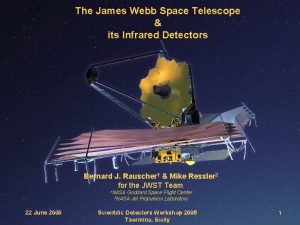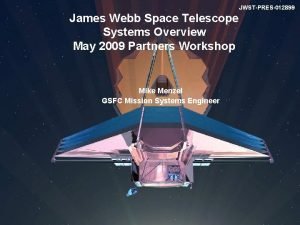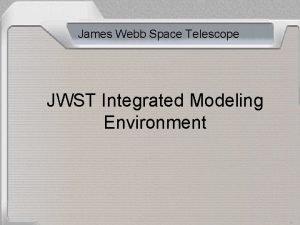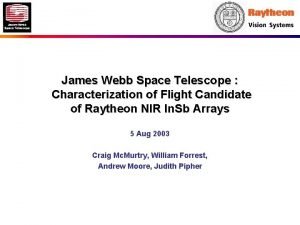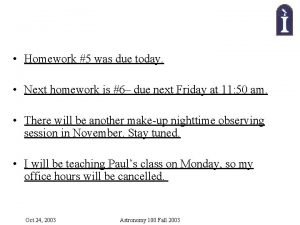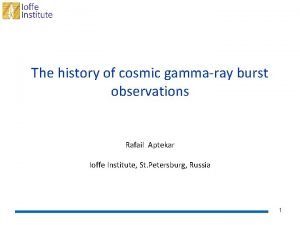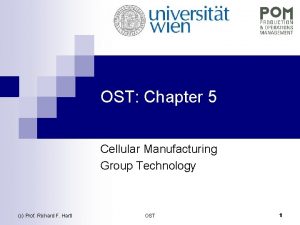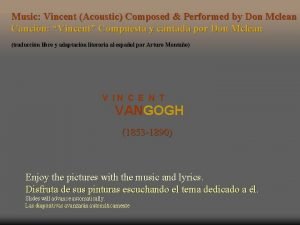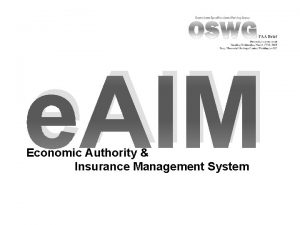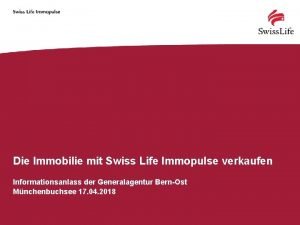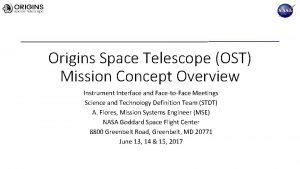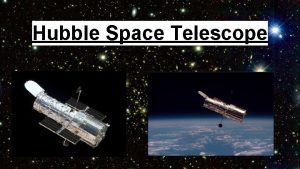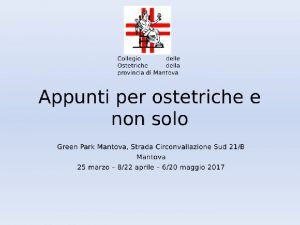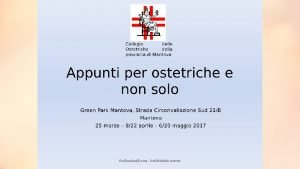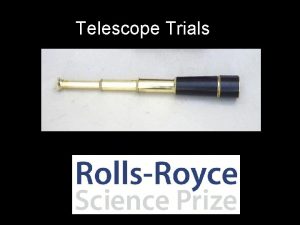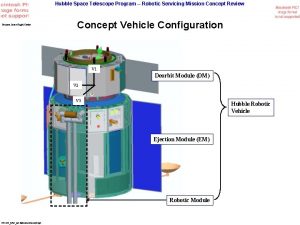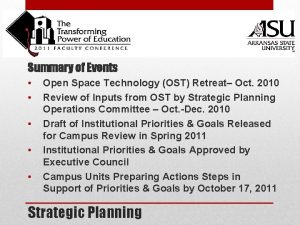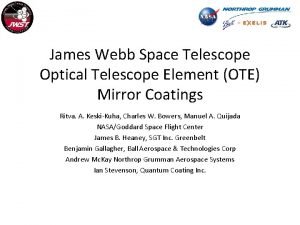Origins Space Telescope OST Mission Concept 1 Open









![Bus Volume Area of red triangle =1/2[(14257)/2]^2 = 903 in^2 57” Area of DTA Bus Volume Area of red triangle =1/2[(14257)/2]^2 = 903 in^2 57” Area of DTA](https://slidetodoc.com/presentation_image_h2/5eda128ef4e371df6ab70b338fdf97cf/image-10.jpg)


- Slides: 12

Origins Space Telescope (OST) Mission Concept 1 Open Issues Face-to-Face #5 June 1 -2, 2017 Ruth. C. Carter@nasa. gov 1

Concept 1 Design Status/Issues • Concept 1 mass is ~2, 000 kg over the launch vehicle (Vulcan Aces 5 m fairing) lift capability – Mass for 5 instruments is 2643 kg • • • Far-IR Imager/Polarimeter (FIP): 781 kg High Resolution Spectrometer (HRS): 935 kg Medium Resolution Survey Spectrometer (MRSS): 435 kg Heterodyne Instrument (HI): 383 kg Mid-IR Spectrometer/Imager/Coronagraph (MISC): 108 kg • Optical ray traces for instruments are still in progress and some are near completion – Elimination of any of these instruments will result in rework of ray traces and packaging for remaining instruments • Fairing volume is extremely tight and uncertain, overall packaging is uncertain and deployment is still TBD • Current Concept 1 is too heavy to be launched on a 5 m fairing – Volume is tight and uncertain 2

Solution: Larger Launch Vehicle (LV) • NASA Space Launch System (SLS) has larger mass and volume capabilities to accommodate current OST Concept 1 – Fairing Sizes: 8. 4 x 19 m, 10 m x 31 m • SLS will be available in 2030’s when OST will be ready to launch – Both LUVOIR and Hab. Ex mission concepts include SLS • SLS is a development program and it is yet to have a first launch – Higher risk item in mission development • Larger LV cost will be higher, however larger volume may allow flight system design to be less complex, resulting in lower mission cost overall 3

Study Office Plan and Request • Plan to work with instrument teams to scale down instrument volume, mass and power to fit into a 5 meter fairing • In the event that the scaled down instruments results in exceeding 5 m fairing capabilities, we need design flexibility to assume a larger LV – In order to complete Concept 1 design by 9/30/17, we need design flexibility • Study Office requests STDT permission to go to a larger launch vehicle, if necessary – Need a decision by 6/15/2017, 5 pm 4

Study Schedule 5

Back -Up 6

OST Concept 1 Design Parameters • 9 meter diameter primary mirror – Segmented, Off-Axis Telescope • 5 science instruments – – – Far-IR Imager/Polarimeter (FIP) High Resolution Spectrometer (HRS) Medium Resolution Survey Spectrometer (MRSS) Heterodyne Instrument (HI) Mid-IR Spectrometer/Imager/Coronagraph (MISC) • Instrument Accommodation Module (IAM) • 8 cryo-coolers to cool and maintain Telescope and IAM at 4 Kelvin • Launch on a 5 meter fairing launch vehicle – Vulcan Aces assumed • Mission Operations Orbit is Sun Earth L 2 7

5 m Fairing Design Challenges 1. Mass exceeds allowable. 2. Stowing and deploying Sunshade and Baffle: - Might be enough space to do it in current configuration – TBD. Stowed stack -up only allows for. 75 m in height for stowing Sunshade. - Engineer, with in-depth knowledge of JWST Sunshade design, is just starting to look at it. - Cable harnesses and cryo lines (volume TBD) need to stow in same area as Sun Shade. May not be enough room for it all. - How to deploy the cable harnesses and cryo lines AND the Sunshade when they all stow in same location may be unworkable. - May not be enough room in bus to store everything. Many deployment booms are needed for Sunshade. Large prop tank takes up a lot of room, as well. Layout of Bus is TBD. 3. Currently HRS instrument interferes with lower corner of stowed Primary Mirror • Packaging of HRS might not allow for removal of interference – TBD. • Removing one hex segment of PM required if HRS interference remains. 4. CG if stowed assembly will be rather high. High CG and high mass may preclude using this launch vehicle. 8

Layout shown is a bit obsolete, but the. 75 m space is accurate, given current launch vehicle fairing limitation. 9
![Bus Volume Area of red triangle 121425722 903 in2 57 Area of DTA Bus Volume Area of red triangle =1/2[(14257)/2]^2 = 903 in^2 57” Area of DTA](https://slidetodoc.com/presentation_image_h2/5eda128ef4e371df6ab70b338fdf97cf/image-10.jpg)
Bus Volume Area of red triangle =1/2[(14257)/2]^2 = 903 in^2 57” Area of DTA = Pi x D^2/4 = Pi x 40 in^2/4 = 1256 in^2 142” Area of sunshade = TBD Area of bus top shape without DTA area = 142^2 – 4(903”) – 1256 = 20, 164 in^2 – 3, 612 in^2 – 1256 in^2 = 15, 296 in^2 (9. 8 m^2) Volume available for sunshade stowage and cable harnesses and cryo lines = 9. 8 m^2 x. 75 m = 7. 35 m^3 10

Concept 1 Mass Estimates preliminary and immature 11

Potential Launch Vehicles Notes: 1) FT – Full Thrust is the latest version of the Falcon 9; versions v 1. 1 and v 1. 0 are retired from service. 2) ECA - The Ariane 5 ECA (Evolution Cryotechnique type A), first successfully flown in 2005, uses an improved Vulcain 2 first-stage engine with a longer, more efficient nozzle with a more efficient flow cycle and denser propellant ratio. The Ariane 5 ECA has a GTO launch capacity of 9, 100 kg (20, 100 lb. ) for dual payloads or 9, 600 kg (21, 200 lb. ) for a single payload. ES - the Ariane 5 ES (Evolution Storable) has an estimated LEO launch capacity of 21, 000 kg (46, 000 lb. ). Ariane versions A 5 G, A 5 G+, and A 5 GS are retired from service. 3) L 2 - Lagrange point 2 named after Joseph Lagrange, an 18 th century mathematician, who found the solution to the “three-body problem”. In astrodynamics, the characteristic energy (C 3) is a measure of the excess specific energy over that required to just barely escape from a massive body. The units are length 2/time 2, i. e. , energy per mass. In this case an initial C 3 estimate of -0. 5 km 2/sec 2 to L 2 was assumed. 4) Assumes the Drone recovery option for the Falcon 9 FT 1 st Stage and launch from SLC-41 at CCAFS. 12

